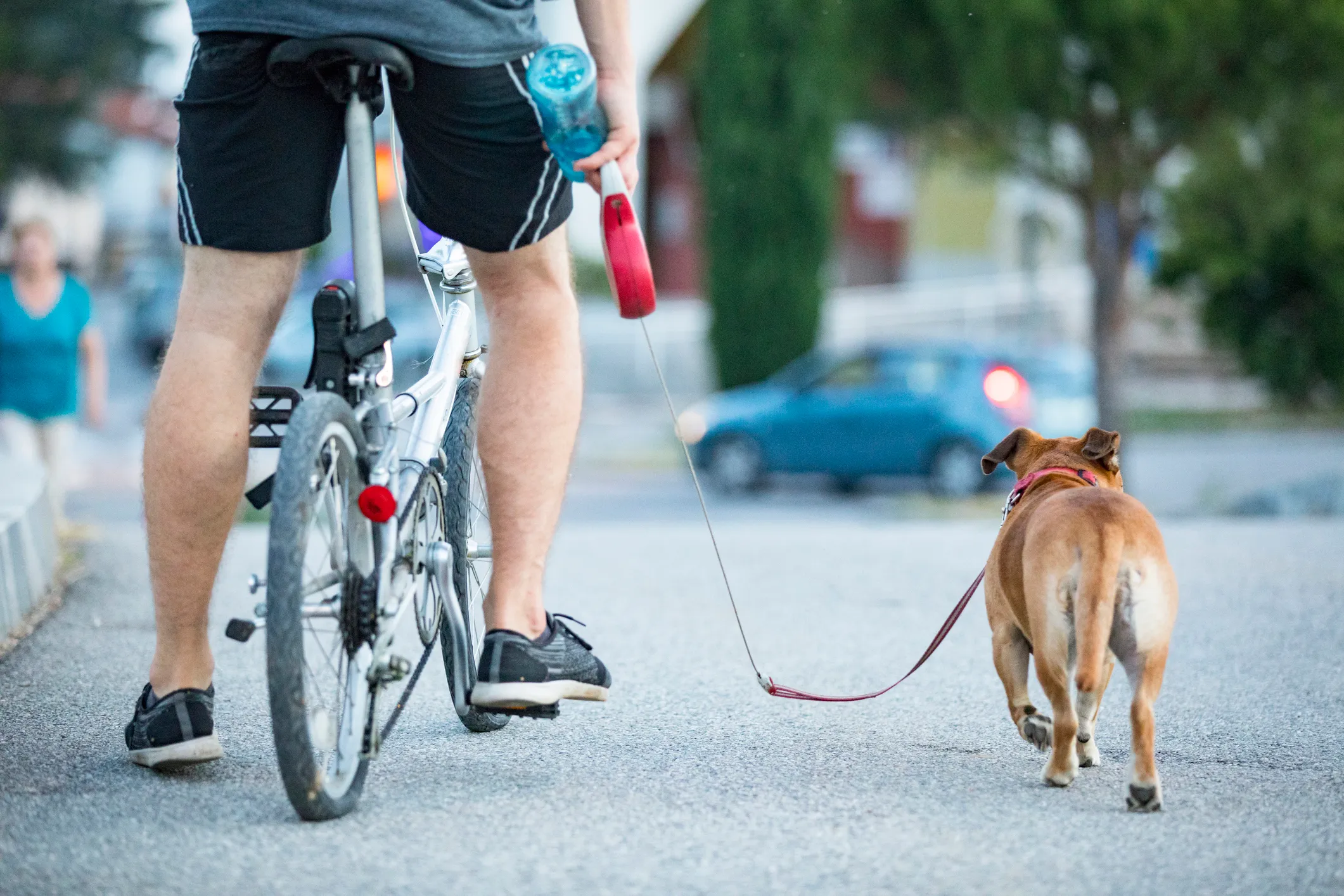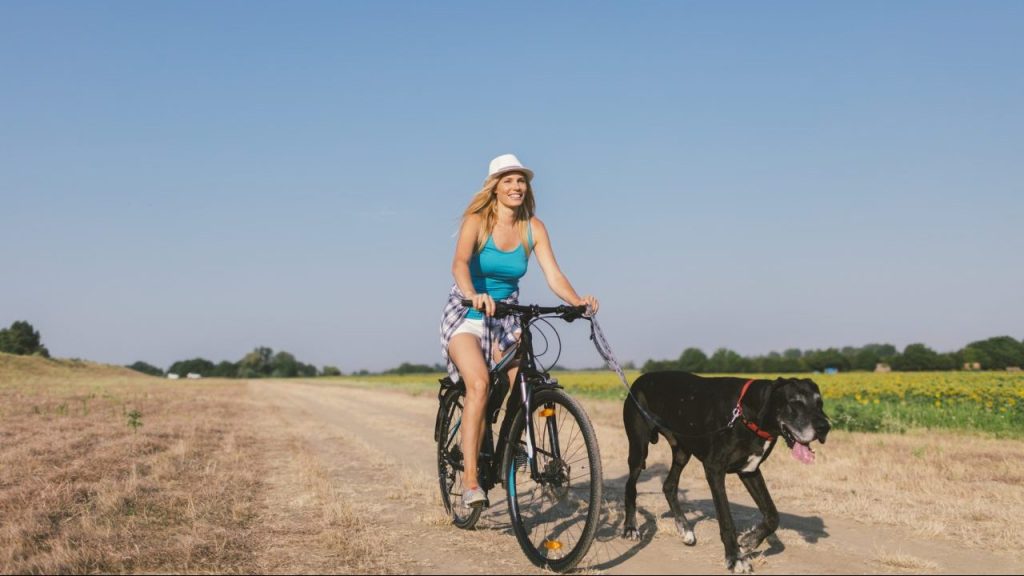Biking with dogs can be a fantastic way to combine exercise, fresh air, and quality time with your furry companion. However, following proper etiquette and keeping you and your dog safe is essential. This guide will outline the dos and don’ts of biking with dogs, helping you create enjoyable and safe adventures together.
Dos of Biking With Dogs

Evaluate your dog’s fitness level and athletic ability
Before embarking on biking adventures, evaluate your dog’s physical fitness, athletic ability, and overall health. Certain dog breeds may be better suited for biking, while others may struggle. Consult with your veterinarian to determine if your dog is fit for biking.
Seek veterinary advice
Before starting any biking routine, consult with your veterinarian. They can assess your dog’s health, provide guidance on appropriate exercise levels, and address any specific concerns regarding your dog’s breed or health needs.
Invest in proper gear
Invest in high-quality biking gear and equipment to ensure a safe and comfortable biking experience for your dog. Essential equipment includes a well-fitting harness or biking-specific leash attachment. Avoid using retractable leashes while biking, as they can tangle or cause accidents.
Start slow and short
Begin your biking journey with short, slow rides to allow your dog to acclimate to the activity. Gradually increase the intensity and duration of rides as your dog builds endurance and confidence.
Choose dog-friendly routes
Select biking routes that are safe and suitable for dogs. Avoid busy roads, heavy traffic areas, and crowded parks. Look for trails, bike paths, or quiet roads where you and your dog can enjoy a peaceful and stress-free ride.
Maintain control
Keep your dog on a short leash or use a bike attachment designed to secure your dog safely. These tools help you maintain control and prevent accidents or unexpected encounters with pedestrians, other animals, or vehicles.
Hydration is key
Bring a water bottle and a collapsible bowl to hydrate your dog during breaks. Offer water regularly, especially on warmer days, to prevent dehydration and overheating.
Monitor your dog’s well-being
Pay close attention to your dog’s body language and signs of fatigue or distress while biking. Take breaks as needed and allow your dog to rest and recover. If your dog shows signs of discomfort, such as excessive panting or limping, stop the ride and seek veterinary attention if necessary.
Clean up after your dog
Be a responsible pet owner and clean up after your dog. Carry waste bags and dispose of them properly in designated bins. Respect public spaces and ensure they remain clean and welcoming for everyone.
Don’ts of Biking With Dogs

Avoid biking with young puppies
Young puppies with developing skeletal systems should not go on bike rides. Wait until they are older and fully developed before introducing them to biking activities.
Skip biking with dogs with health issues
Dogs with existing health issues, joint problems, or breathing difficulties should not participate in biking activities. It’s essential to prioritize their well-being and engage in alternative forms of exercise recommended by your veterinarian.
Steer clear of extreme weather conditions
Avoid biking in extreme weather conditions, such as scorching heat or freezing cold. These conditions can be uncomfortable and potentially harmful to your dog. Opt for cooler times of the day or consider indoor exercise alternatives during extreme weather.
Don’t force your dog to run faster than comfortable
Allow your dog to set the pace during biking. Don’t force your dog to run faster than they are comfortable, as it can strain their muscles or lead to exhaustion. Pay attention to their natural gait and adjust your speed accordingly.
Avoid leaving your dog unattended
Never leave your dog unattended while attached to your bike or tied up outside establishments. Dogs can become anxious or scared when left alone in unfamiliar environments, leading to potential accidents or escapes.
Avoid crowded and busy areas
Choose biking routes that are away from busy areas or crowded parks. Dogs can become overwhelmed or anxious in chaotic environments, increasing the risk of accidents or undesirable behavior.
Check your dog’s paws
After each biking session, examine your dog’s paws for injuries or abrasions. Rough terrain or sharp objects on the ground can cause paw pad injuries. Consider using protective booties to prevent such injuries.
Prevent chasing behavior
Discourage your dog from chasing wildlife, other animals, or pedestrians while biking. Maintain control of your dog and reinforce obedience commands to ensure their behavior remains safe and controlled.
Don’t neglect training and obedience
Maintain consistent training and reinforce obedience commands while biking with your dog. Ensure they respond to cues such as “stop,” “heel,” and “leave it.” These measures help keep both you and your dog safe during rides.
More fun activities to do with your dog
Biking with your dog can be a wonderful experience that promotes exercise, bonding, and exploration. By following these dos and don’ts, you can ensure your four-legged friend’s safety, comfort, and well-being during biking adventures. Prioritize their fitness, health, and happiness, and enjoy the remarkable journey of biking with your loyal companion.
Looking for more activities to do with your dog? Check out our guides to boating with dogs or attending a parade with your pup!
ChatGPT assisted in the creation of this article.









